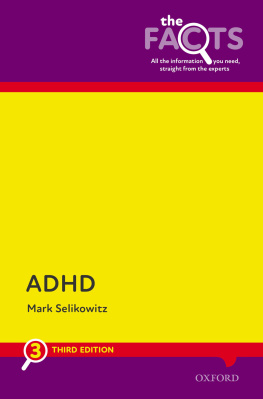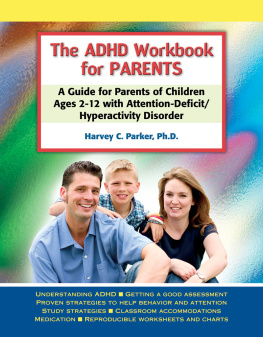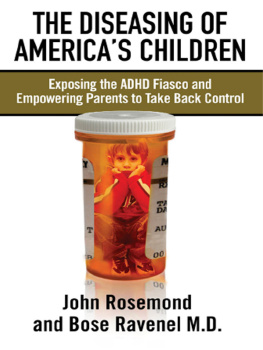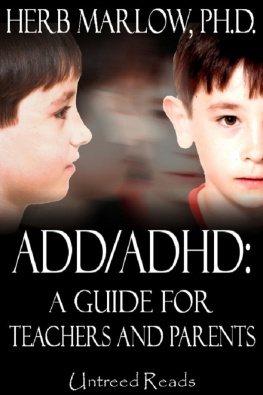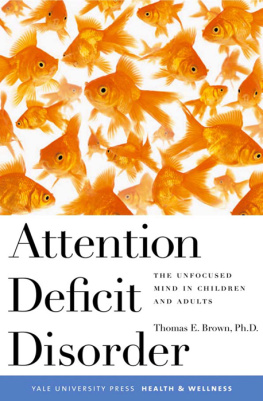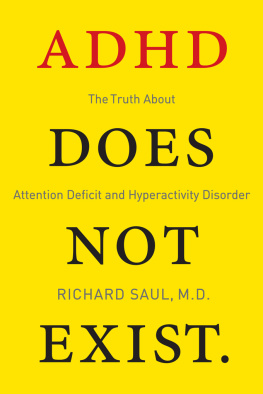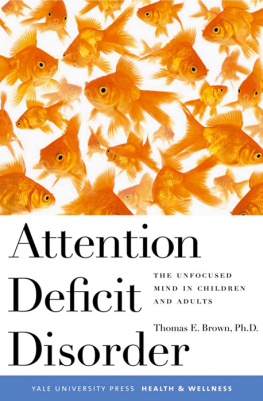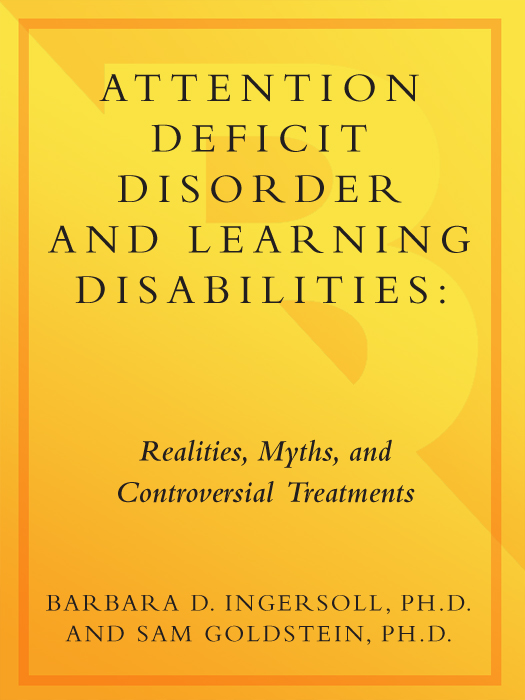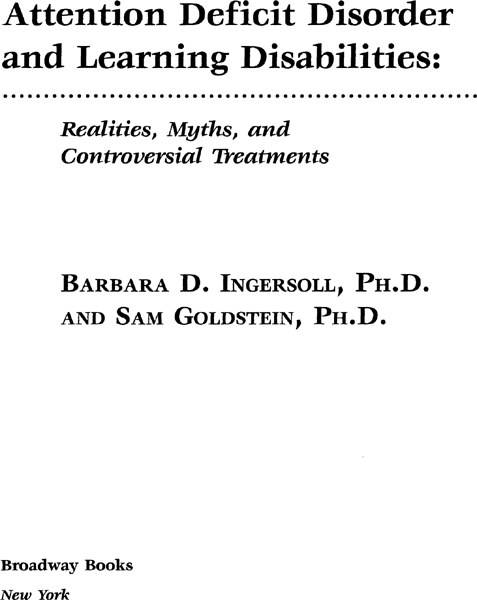Also by Barbara D. Ingersoll, Ph.D.:
Your Hyperactive Child
Also by Sam Goldstein, Ph.D.:
Managing Attention Disorders in Children
This work is dedicated to Janet, Allyson, and Ryan Goldstein for their patience and support and to Tom Ingersoll for his editorial contributions and attention to detail. We wish to thank Kathleen Gardner for superb clerical expertise and Sarah Cheminant, who always manages to locate even the most remote research citation.
C ONTENTS
I NTRODUCTION
Are Alternative Treatments Good Alternatives?

SECTION I
C HAPTER 1
C HAPTER 2

SECTION II
C HAPTER 3
How New Treatments Are Evaluated: Science,
Pseudoscience, and Quackery
C HAPTER 4
C HAPTER 5

SECTION III
C HAPTER 6
The Orthomolecular Approach:
Megavitamins and Mineral Supplements
Anti-Motion-Sickness Medication:
ADHD and the Inner Ear
C HAPTER 7
C HAPTER 8
C HAPTER 9
Neural Organization Technique:
The Chiropractic Approach
A UTHORS N OTE
The American Psychiatric Association has officially adopted the term Attention Deficit Hyperactivity Disorder (ADHD) to describe the condition commonly referred to as Hyperactivity or Attention Deficit Disorder. Although Attention Deficit Hyperactivity Disorder may most accurately describe the condition, it can be unwieldy; so we often use the more common terms, interchangeably, throughout this book.
For convenience, we use the masculine he to indicate both genders.
I NTRODUCTION
Are Alternative Treatments
Good Alternatives?
There are 63 million children under the age of eighteen in the United States. The most conservative estimates suggest that at least 3 to 5 percent have Attention Deficit Hyperactivity Disorder (ADHD), a condition the American Psychiatric Association includes among the so-called disruptive behavior disorders. These disorders are characterized by behavior that is disruptive and disturbing to others in the childs environment. In comparison with children of similar age, children with ADHD have difficulty maintaining attention and remaining on-task, especially if the task is somewhat routine or monotonous. Children with ADHD are also quite impulsive, often acting before they think about the likely consequences of their actions. In addition, many ADHD children are much more fidgety, restless, and active than their age-mates, especially in situations which call for quiet or subdued behavior.
Children with ADHD often have other problems, including learning difficulties and poor school performance. As many as one quarter actually have documented learning disabilities; that is, there is a significant discrepancy between their overall intellectual abilities and their ability to learn academic skills. Despite an apparently normal or even superior capacity to learn, learning-disabled children lag far behind their classmates in their struggle to master reading, spelling, writing, and other academic tasks.
Just as many ADHD children suffer from learning disabilities, the converse is true, as well: of the 5 to 10 percent of children in the United States who are learning-disabled, about one third also have ADHD. From these figures, we can conclude that between 5 and 10 million children in the United States have ADHD and/or learning disabilities.
In centuries past, these children were capable of blending into a work force primarily driven by manual labor. Many were simply released from school and written off as bad, or stupid, or lazy. Some were warehoused in special education programs or juvenile detention facilities; others were sent off to boarding school or to join the army; still others simply drifted into low-paying jobs and a marginal existence on the fringes of society. Although some exceptional individuals like Winston Churchill, who had ADHD, and Thomas Edison, who was learning-disabled, overcame their early difficulties and went on to achieve great personal and professional success, many more did not.
It is to the credit of our societyand thanks to the unstinting efforts of thousands of dedicated parents and professionalsthat we no longer tolerate such conditions for these children. In the late 1970s, largely through the efforts of parent-professional support groups like the Association for Children and Adults with Learning Disabilities, Public Law 94142, the Education for All Handicapped Children Act, was enacted. This law, reauthorized in 1990 as the Individuals with Disabilities Education Act, mandates appropriate educational services for children with learning disabilities and other handicapping conditions, in every state in the country. Similar laws have since been enacted in other countries, including Canada.
More recently, there has been a tremendous upsurge of interest in the problems of children with ADHD. This interest is reflected not only in the increased number of books and articles in the scientific literature but also in the explosion of material directed at parents and teachers. Parents and professionals have joined forces in support groups, such as the Attention-Deficit Disorder Association (ADDA) and the Attention Deficit Disorder Advocacy Group (ADDAG), which have sprung up across the country. The largest of these is Children and Adults with Attention Deficit Disorders (CH.A.D.D.). Founded in 1987, this organization currently has chapters in all fifty states and a membership in excess of twenty thousand. Parent-professional groups such as CH.A.D.D. play a major role in drawing attention to the special needs of ADHD children and in lobbying to see that these needs are met. Thanks to their efforts, for example, the United States Department of Education issued a policy statement in September 1991 in which children with ADHD were expressly recognized as eligible for special education and related services under federal law. This represents a major victory for ADHD children, many of whom were formerly denied special services in school systems in which ADHD was not recognized as a handicapping condition.
MYTHS, MISINFORMATION, AND THE MEDIA
The problems of children with ADHD have also attracted the attention of the media. In fact, if television and the popular press are any indication, ADHD is the in childhood disorder of the 1990s. With a great deal of heat but very little light or enlightenment, this condition has been showcased on a host of radio and television talk shows. It has also been featured in popular magazines, newspaper columnseven in the tabloids we read while standing in the checkout lane at the supermarket.


